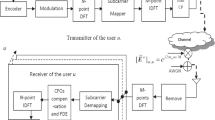Abstract
Multicarrier code division multiple access (MC-CDMA) systems have arrested a lot of attention, owing to the simple implementation and powerful resistance to frequency-selective channels and the CDMA with the suitability for multiuser systems. Although MC-CDMA systems spread symbols using orthogonal codes to ensure orthogonality, orthogonality may be destroyed at the receiver due to frequency selective fading and then results in multiple access interference (MAI) and inter-carrier interference (ICI). The space-alternating generalized expectation–maximization (SAGE) algorithm is with high convergence speed and performs maximum-likelihood estimation/detection of the transmitted signals. For MC-CDMA systems, existing SAGE algorithm is used to cancel the ICI (Panayirci et al. in IEEE Trans Signal Process 58(8): 4225–4238, 2010), or to cancel the MAI (Panayirci et al. in 16th IST Mobile and Wireless Communications Summit, 2007). In this paper, the proposed interference cancellation scheme not only performs MAI cancellation but also performs ICI cancellation for the MC-CDMA systems. Some simulation examples are given to show the effectiveness and comparisons of the proposed receiver.








Similar content being viewed by others
References
Yee, N., & Linnartz, J.-P. (1994). Controlled equalization of multi-carrier CDMA in an indoor Rician fading channel. IEEE Vehicular Conference, 3, 1665–1669.
Fazel, K. (1994). Performance of convolutionally coded CDMA/OFDM in a frequency-time selective fading channel and its near-far resistance. IEEE International Conference on Communications, 3, 1438–1442.
Ahmed, J., & Hamdi, K. (2013). Spectral efficiency of asynchronous MC-CDMA with frequency offset over correlated fading. IEEE Transactions on Vehicular Technology, 62(7), 3423–3429.
Tsai, S.-H., Lin, Y.-P., & Kuo, C.-C. J. (2005). An approximately MAI-free multiaccess OFDM system in carrier frequency offset environment. IEEE Transactions on Signal Processing, 53(11), 4339–4353.
Chitra S., & Kumaratharan, N. (2013) A low complexity receiver phase rotated conjugate cancellation for ICI reduction using iterative ML algorithm in MC-CDMA system. In: International Conference on Computer Science and Education (ICCSE).
Abudoukeremu, A., Huang, J., Ida, Y., Matsumoto T., & Matsufuji, S. (2014). On BER performance of block coding MC-ZCZ-CDMA. In: International symposium on information theory and its applications (ISITA), pp. 516–520.
Rasadurai, K., & Kumaratharan, N. (2012). Performance enhancement of MC-CDMA system through turbo multi-user detection. In: International conference on computer communication and informatics, pp. 1–7.
Shi, Q.-H., & Latva-aho, M. (2005). Accurate bit-error rate evaluation for synchronous MC-CDMA over Nakagami-m-fading channels using moment generating functions. IEEE Transactions on Wireless Communications, 4(2), 422–433.
Tsai, S.-H., Lin, Y.-P., & Kuo, C.-C. J. (2006). MAI-Free MC-CDMA systems based on hadamard-walsh codes. IEEE Transactions on Signal Processing, 54(8), 3166–3179.
Panayirci, E., Senol, H., & Poor, H. V. (2010). Joint channel estimation, equalization, and data detection for OFDM systems in the presence of very high mobility. IEEE Transactions on Signal Processing, 58(8), 4225–4238.
Li, X., Zhou, R., Hong, S., & Wu, Z. (2010) Total Inter-Carrier Interference Cancellation for MC-CDMA System in Mobile Environment. IEEE Global Telecommunications Conference, pp. 1–6.
Sundhar, A., & Dananjayan, P. Capacity improvements of MCCDMA-MIMO system through power control using water filling game theory under imperfect channel state conditions. In International conference on advanced communication control and computing technologies (ICACCCT), pp. 23–27.
Penmetsa, D., & Muthuchidambaranathan, P. (2012). A novel method for Complete Inter-carrier Interference cancellation for MC-CDMA systems. In Third International Conference on Computing Communication & Networking Technologies, July 2012, pp. 1–5.
Jang, W. M., Lim, N., & Lee, M. W. (2008). MAI and ICI of Asynchronous Uplink MC-CDMA With Frequency Offset. IEEE Transactions on Vehicular Technology, 57(4), 2164–2179.
Dempster, A., Laird, N., & Rubin, D. (1977). Maximum likelihood from incomplete data via the EM algorithm. Journal of the Royal Statistical Society Series B, 39, 1–38.
Fessler, J. A., & Hero, A. O. (1994). Space alternating generalized expectation maximization algorithm. IEEE Trans. Signal Processing, 42, 2664–2677.
Kocian, A., & Fleury, B. H. (2003). EM-based joint data detection and channel estimation of DS-CDMA signals. IEEE Transactions on Communications, 51(10), 1709–1720.
Panayirci, E., Dogan, H., Cirpan, H. A., & Fleury, B. H. (2007). An efficient joint data detection and channel estimation technique for Uplink MC-CDMA systems based on SAGE algorithm. 16th IST Mobile and Wireless Communications Summit, July 2007, pp. 1–5.
Panayirci, E., Dogan, H., Cirpan, H. A., Kocian, A., & Fleury, B. H. (2010). Iterative joint data detection and channel estimation for uplink MC-CDMA systems in the presence of frequency selective channels. Physical Communication, 3(2), 87–96.
Zhang, X., & Ryu, H.-G. (2010). Suppression of ICI and MAI in SC-FDMA communication system with carrier frequency offsets. IEEE Transactions on Consumer Electronics, 56(2), 359–365.
Hélard, J.-F., Baudais, J.-Y., & Citerne, J. (2000). Linear MMSE detection technique for MC-CDMA. Electronics Letters, 36(7), 665–666.
Kabaoglu, N. (2011). SAGE based suboptimal receiver for downlink MC-CDMA systems. IEEE Communications Letters, 15(12), 1381–1383.
Jafarkhani, H. (2005). Space-time coding: Theory and practice. Cambridge: Cambridge University Press.
Author information
Authors and Affiliations
Corresponding author
Rights and permissions
About this article
Cite this article
Sung, WL., Chang, YK., Ueng, FB. et al. A New SAGE-Based Receiver for MC-CDMA Communication Systems. Wireless Pers Commun 85, 1617–1634 (2015). https://doi.org/10.1007/s11277-015-2858-4
Published:
Issue Date:
DOI: https://doi.org/10.1007/s11277-015-2858-4




